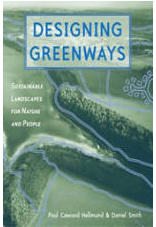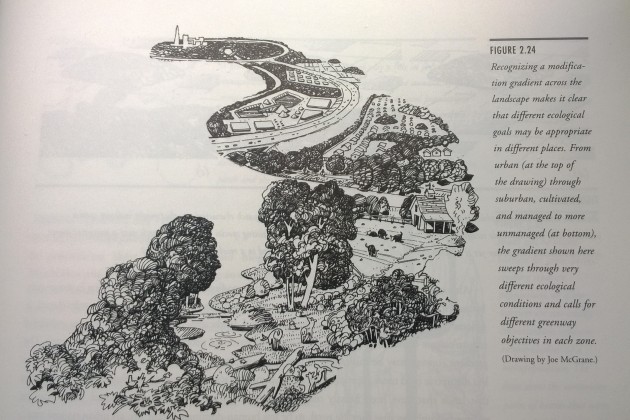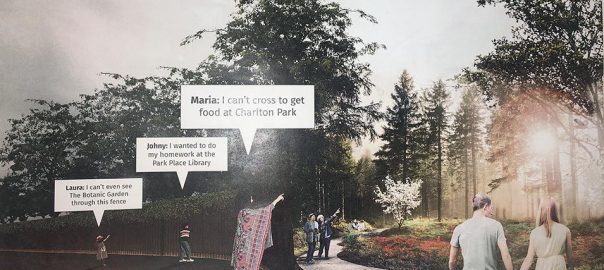A review of Designing Greenways: Sustainable Landscapes for Nature and People (Second Edition), edited by Paul Cawood Hellmund and Daniel Somers Smith. 2006. ISBN 1-55963-325-5. Island Press, Washington. 270 pages.
Greenways (GW)—from wide wild areas to narrow urban trails—are linear bands of land and water designed and managed for multiple purposes such as nature conservation, flood water management, water quality protection, recreation and many other social functions. Revalued since the middle of last century, when ecology became prominent in planning and design, and strengthened by a solid theoretical framework (island biogeography and landscape ecology) and by analysis tools such as GIS and remote sensing, GW have a renewed popularity through their significant social and ecological functions, performing many services at the same time.
 In this collaborative manual editors Paul Cawood Hellmund and Daniel Somers Smith explain the biophysical natural and social ecological functions of GW, and how they can help to solve fragmentation, conservation and functional problems of the landscape in a changing world adding value to ecosystems and people alike.
In this collaborative manual editors Paul Cawood Hellmund and Daniel Somers Smith explain the biophysical natural and social ecological functions of GW, and how they can help to solve fragmentation, conservation and functional problems of the landscape in a changing world adding value to ecosystems and people alike.
Paul C. Hellmund is an educator, landscape planner + designer, director of the Conway School of Landscape Design in western Massachusetts, North America. His co-author, Daniel Somers Smith has a background in forest science and is an educator in environmental studies. Other chapters that complete the work are due to R.F. Noss, M.W Binford, R. J. Karty and L. Fisman. In their contributions all authors emphasize the imperative to find a balance between nature and people being creative and critical as a key factor in building sustainable landscapes through collaborative and adaptive design.
 Designing Greenways belongs to a series books with mentors such as Design with Nature (McHarg 1969), The Granite Garden: Urban Nature And Human Design, (A. W. Spirn 1985), and more recent books such as Green Infrastructure: Linking Landscapes and Communities (M.A. Benedict and E.T. McMahon, 2006), Sustainable Infrastructure: The Guide to Green Engineering and Design (S. Bry Sarte 2010), Green Infrastructure: A Landscape Approach (D.C. Rouse and I. F. Bunster-Ossa 2013), just to mention a few. All these works have a common theme: the aim to broadcast the benefits of green infrastructure taking advantage of the natural landscape as mitigation efforts in a world of social and ecological fragmentation.
Designing Greenways belongs to a series books with mentors such as Design with Nature (McHarg 1969), The Granite Garden: Urban Nature And Human Design, (A. W. Spirn 1985), and more recent books such as Green Infrastructure: Linking Landscapes and Communities (M.A. Benedict and E.T. McMahon, 2006), Sustainable Infrastructure: The Guide to Green Engineering and Design (S. Bry Sarte 2010), Green Infrastructure: A Landscape Approach (D.C. Rouse and I. F. Bunster-Ossa 2013), just to mention a few. All these works have a common theme: the aim to broadcast the benefits of green infrastructure taking advantage of the natural landscape as mitigation efforts in a world of social and ecological fragmentation.
The six chapters Designing Greenways, including a special chapter on riparian GW (Chapter 4) present definitions, conceptual theoretical and practical frameworks, scientific knowledge based on an abundant bibliography and case studies, describing the multidimensional GW functions and various human activities that impact corridors. Chapter 5 gives a framework to understand the connections and relationships between Society and Nature.
The key chapter in this book (chapter 6) provides a useful method in five stages to guide the conceptualization and planning of GW projects. This tool, of great use for applications in design, integrates concepts and technical outfits from previous chapters.
Although the book seems to be directed at the American readers—most of the examples noted are U.S. based—the content has a global scope, giving readers most of what they need to know about these issues. To me, here is the only weakness shown in this book. In a global world there are many enriching GW examples in other parts of the world. These would have been interesting to mention.
Authors describe the evolution of GW in the USA from parkways in the 1860s, when mentor Olmsted recognised the great potential of linear greenspace to connect neighbourhoods providing access to city parks. No reference is given to influences of Olmsted’s travels in China and Europe, which were definitely inspirational sources linking also to a predilection for the pastoral picturesque architecture of the English countryside, a model that has lasted until the present day. Early English influences can be also found in the green belt policy, a restriction of building around cities that can be traced back to the ancient times. Leaving aside this, Designing Greenways can be considered a masterpiece, being comprehensive from different theoretical perspectives and practices of the multiple disciplines involved in a GW design and implementation.
The book succeeds posing the significance to work in achieving landscape integrity without forgetting that GW are not a conservation panacea. The features that strengthen the corridors—such as linearity, connectivity, accessibility, multitasking—represent at the same time many weaknesses. For example, the high ratio of edge to interior make the ecology of GW very vulnerable to human pressure, predation and biological invasions.
GW projects are nowadays popular because of their multiple benefits. A disadvantage of this popularity is that they are associated with the wrong assumption that they are relatively easy to implement. They are not, and along the pages the authors confront us with the reality of the real world. They warn readers not to be dazzled by the many attractive benefits, calling us to reflect that designed GW projects, in order to succeed, should be integrated in the landscape. They recommend that designers must firstly understand the structures and functions of the system they want to restore. Secondly, they should move to the project stages by answering a series of strategic questions through spatial (local to global) and temporal scales, being aware of possible risks and failures that can result from oversimplification or wrong assumptions.
This book presents scientific information in a way that may be accessible to non-specialists integrating scientific principles into a comprehensive design method. Easy to read from start to finish, it can be used in several ways: as a unit, with a focus on some chapters following personal interests, or as a guide.
Although eight years have passed since its publication Designing Greenways remains valid as a great contribution and provides a practical guide for planners, landscape architects, educators, students, citizen groups and conservationists to move from theory to action.
I strongly recommend this book.
 Star rating: Excellent, in achieving its own objectives and as a valuable contribution to TNOC readers
Star rating: Excellent, in achieving its own objectives and as a valuable contribution to TNOC readers
by Ana Faggi
Buenos Aires







Leave a Reply